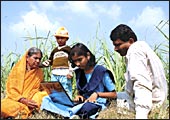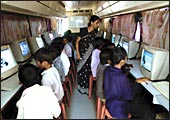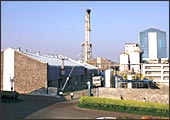 |
| Lapping it up: Fourteen-year-old
Aarti giving her uncle a lowdown on the month's expenses |
Tourteen-year-old
Aarti Dhawan flips open her sleek, black Compaq laptop and conjures
a PowerPoint slide for my benefit-all with a beatific smile. She
then clicks on an Excel spreadsheet and explains the month's expenses
to her 33-year-old uncle, Santosh Dhawan. A sugarcane field is
an unlikely place to use a laptop, but if you are in Baramati,
the sugarcane heartland of Maharashtra, you might not find many
other places to use one. The shy, class nine student first saw
a computer about two years ago at a computer lab in her school.
Since then, Aarti has not only managed to master simple applications
like Word, Excel and PowerPoint, but has also coaxed her uncle,
a small farmer with 30 acres of land, to open an e-mail account
and surf the internet. A year ago, they purchased a desktop that
they use at home to access the net for agriculture-related information.
"We surf the net to find out, for example, how to cultivate
different varieties of grapes," says a smiling Aarti.
 |
| Information point: Common
service centres (like this one) also provide information on
prices of commodities |
 |
| Catching them young: Children
being taught how to use computers at a mobile computer lab
|
For now, the young girl is glad to tally the
accounts of her uncle's farm on her brand new laptop-a gift from
Intel's Chairman Craig Barrett, who visited the girl's home a
month ago. "That's the cow from which we gave Mrs Barrett
a glass of milk," says Dhawan, pointing at a sturdy beast
tied up in the courtyard. Even as Aarti surfs the information
superhighway with élan, she takes a potholed road during
her holidays to a remote village 60 km away. The reason: her parents
live there. Aarti has been staying with her uncle and family because
the only decent school in the vicinity is in Baramati. That's
the emerging paradox of Baramati and much of developing rural
India-a girl who uses a Compaq laptop to access the net, nevertheless,
has to stay away from her parents so that she can get a decent
education. But that's a different story.
Plug and Play
Baramati, sugarcane heartland and Sharad
Pawar stronghold, has about 100 villages that largely earn their
livelihood from agriculture and cattle farming. As you enter Baramati,
the first thing that you feel is the smooth road, in sharp contrast
to the bumpy, spine-jarring road that connects Pune to the small,
dusty taluka. A tough find on the map of India, it's this obscure
taluka, nearly 120 km from Pune, that tech giant Intel chose to
implement a pioneering WiMax project. This technology allows internet
connectivity over long distances, theoretically, as much as 30
km. Simply put, WiMax is 'Wi-Fi on steroids' (See The WiMax FAQ).
So, why did Intel choose Baramati? For one, the support from the
local authorities led by Sharad Pawar was forthcoming. Two, a
local college, Vidya Pratishthan's Institute of Information Technology
(VIIT) has been doing pioneering information, communication and
technology (ICT) work. Pawar, incidentally, is a member of the
governing council of VIIT. Also, given the topography of Baramati-with
villages spread far and wide-the success of WiMax would be a standup
case for WiMax as a medium for last mile connectivity in rural
areas. Intel is using WiMax to connect a series of five community
internet kiosks spread across five villages in the taluka to the
VIIT campus, which will serve as a base camp for the WiMax implementation.
(In other words, Baramati still doesn't have 'mobile' WiMax-that
is, Aarti still can't surf the internet from her uncle's farm,
but must go to an internet kiosk.) Of the five villages, Katewadi
is the closest at a distance of 10 km from the VIIT campus, while
the rest of the villages are at least 20-25 km away from the campus.
Physically wiring up these community kiosks for internet connectivity
would not only have been costly, but also a logistics nightmare.
THE OTHER REVOLUTION
Dairy farmers benefit from a different
sort of technology. |
 |
| Cool concept: Dynamix's
cooler ensures that farmers do not have to worry about
their milk going bad |
A decade ago, Prakash Kumar Jagtap,
had two cows. Every day, he would rise at the crack of dawn,
milk the cows and rush around the small town of Baramati to
sell the milk as soon as possible. But there was a problem:
"Every week nearly Rs 350 worth of milk was going to
waste," recollects Jagtap. That story has considerably
changed since. Across the road from his dairy is a giant cooler
that can store 2,000 litres of milk. It belongs to Dynamix,
the largest dairy company in Maharashtra, which supplies milk
products like yoghurt, and mozzarella cheese to multinational
giants like Nestle and Pizza Hut from this plant at Baramati.
Nearly 60 per cent of the plant's products are exported to
the US and Europe.
In all, Dynamix collects nearly a million litres of milk
from five districts, including Baramati. "We plan to
have 250 more coolers by June 2007, in addition to the 250
we already have," says Vinit Shah, plant manager at
Dynamix. The secret to Jagtap's and Dynamix' success lies
in the fact that it changed the way milk was collected in
Baramati. As soon as a farmer like Jagtap arrives at any
of the 250 collection centres with his milk can, a sample
is taken for test. The sample's fat content shows up on
a screen that, in turn, determines the price of the milk.
A printed receipt is instantly handed out to Jagtap that
shows the milk's fat content, weight and price. Within a
period of 10 days, Jagtap gets his dues. Today, Jagtap has
increased his cattle count from two to 12 and zips around
on a Hero Honda.
|
The kiosks, called common services centres,
provide internet access in addition to other services like giving
out prices of commodities such as wheat, bajra, and sugarcane
for farmers. Villagers can also get basic documentation like land
records, birth and death certificates at the centres. "We
are looking at ICT initiatives that will benefit the common man.
We plan to take services to a village level. Otherwise, a villager
would have to travel to Baramati town to avail these services,"
says Amol Goje, Director, VIIT, and the man spearheading several
ICT ventures happening at Baramati. With an eye on making these
kiosks economically sustainable, most services are available at
a small fee. For example, a land ownership certificate or a caste
certificate would be available for Rs 5. In addition, farm tools
from Mico Bosh, like drills, are available for a rent of Rs 30
per day. Villagers can also make a call or get a document photocopied
at the centre instead of travelling all the way to Baramati town.
 |
| It's not Australia: Courtesy
the internet, Tawde took to rearing EMU and sells their meat
in India |
The Last Mile Challenge
Clearly, it's a mini-it revolution afoot
at Baramati. There are about 136.2 million mobile phone connections
and 40.6 million landline subscribers in India. But the telecommunications
reach is largely confined to the big cities and towns. More than
6 lakh villages in India have no basic telecom service. The biggest
problem in wiring up villages is viability. The cost of rolling
out fibre optic cables across these villages is too prohibitive
for any operator or groups of operators. Even wireless technologies
such as GSM and CDMA don't have the ability at present to deliver
hi-speed data over a large area, and even when 3g comes, enabling
hi-speed delivery of data and video, the problem of reach will
remain. Cable is another last mile solution, but Indian cable
operators have not invested in reaching villages.
 |
| Pioneering work: Goje's
institute serves as the base camp for WiMax implementation |
That's why companies like Intel see WiMax
as an answer to India's last mile problem. For more than two years
now, Intel has been working with cellular operators (Aircel in
the case of Baramati) to offer WiMax on a trial basis. Compared
to Wi-Fi, which has a range of 1,200 metres at most, WiMax can,
theoretically, be delivered over a radius of 30 km, enabling both
point to multipoint and mobile wireless broadband. Intel, globally,
makes the WiMax 'system-on-chip' that allows mobile phones and
laptops to connect with WiMax modems.
Of Emus and ECGs
Even as I visited these community kiosks
in far-flung dusty villages, the sceptic in me kept asking questions-what
can a farmer do with the internet, day after day? How long will
a farmer surf the net for the latest exploits of the sugarcane
borer or the woolly aphid pest? But then, I had forgotten the
basic premise of the internet-that the world of ideas is just
a click away. ITC's eChoupal had proved that only too well. And
I had not met Sandeep Tawde.
GOOD MORNING, BARAMATI
The FM channel is on air for
seven hours every day and reaches out to 30,000 farmers. |
 |
| Rise and shine: Baramati's
community radio channel is all about agriculture, with
some music thrown in |
It is 6 a.m. at Baramati.
As farmers get ready to harvest their sugarcane and grape
crop, 21-year-old Mandar Kinkar puts on a pair of headphones
and starts his day with a crisp Marathi greeting. Kinkar
is a final year student of commerce at a local college and
an announcer for Baramati's community radio channel. The
channel, called Vasundhara Vahini, is on air nearly seven
hours every day-with two slots of three-and-a-half hours
each at dusk and dawn. Of this, Vasundhara Vahini broadcasts
nearly five hours of agriculture-related programming, including
tips for farmers, interviews of agricultural experts and
local farmers who have adopted innovative practices. In
all, the FM channel reaches out to nearly 30,000 farmers
in the region with broadcasts of nearly 150 hours of programming
every month. On Mondays and Thursdays, a programme called
Baazar Bhaav is aired that gives out the rates of commodities
like wheat, bajra, vegetables.
Recently, Baramati also hosted an international grape
production symposium. As experts from Australia and Israel
made presentations at the conference, the event was broadcast
live with a Marathi translation. "Even as the PowerPoint
presentations were being made by foreign experts, farmers
could hear the presentations while working in the fields
with FM sets that were distributed especially for the occasion,"
says VIIT's Amol Goje.
|
| |
| THE WIMAX FAQ |
| What is WiMax?
It stands for worldwide interoperability of microwave
access (WiMax) and, as the name suggests, it's a standards
initiative. But what it really means is wireless broadband
over a wide area.
How is it different from Wi-fi?
Wi-fi is limited to a local area of, say, a few hundred
metres in radius. WiMax, in comparison, can deliver wireless
broadband over a 30-km radius. Using mesh networks Wi-fi
can be delivered across a city, but the quality tends to
suffer.
Will WiMax be available on cell phones?
WiMax has competing technologies, but it's evident that
some time soon, high-speed wireless broadband will be available
on mobile phones.
|
The 37-year-old poultry farmer got into the
business in 1982 with 50 chicken. Since 1993, he had always wanted
to breed birds other than chicken to augment his income. But sources
of information in a small town like Baramati were limited. And
then, in 2002, a cyber café opened at Baramati and Tawde
struck pay dirt. He discovered, on the net, that the EMU (an Australian
bird) could be bred in India. And what's more, EMU meat was far
costlier than that of the chicken he was breeding. An avid Googler
who surfs the net two to four hours every day, Tawde sold nearly
750 kilos of EMU meat last year in India alone at Rs 180 per kilo.
This year, he plans to sell two tonnes of EMU meat. As he sits
in his bare one-room office, people walk in to ask for advice.
"I help people surf the net whenever they come to me for
information. I do that for free," he says.
 |
| A healthy trend: Dr Goje
(R) e-mails ECG readings to a Bangalore hospital and gets
the results in five minutes |
 |
| A mini-IT revolution: WiMax
has opened up a world of opportunities for the five villages
of Baramati |
But stories like that of Tawde are still one-off
instances. The real benefits of technology can be witnessed at
the Rural Hospital at Rui, a stone's throw from the Wi-Fi enabled
VIIT campus. Bapu Atole, 50, is due for a medical check-up for
a suspected heart problem. Normally, a specialised heart check-up
like this would mean a two-and-a-half hour bumpy bus trip to Pune.
The farmer, incidentally, has never left Baramati in his 50 years
on the planet. But Intel's recently launched telemedicine service
saves Atole the hassle of leaving his beloved Baramati. As I watch,
Atole's ECG readings are taken and e-mailed to Narayana Hrudayalaya,
a super specialty hospital in Bangalore. In less than five minutes,
an e-mail from Dr Bomaiah pops up from Bangalore. "Sinus
rhythm within normal limit," reads the e-mail. Case closed.
Says Dr Manjusha Goje (Goje's wife), who runs the clinic: "We
are reaching out with these services to the unreachable."
As I wrapped up my two-day tour of Baramati,
I was left with one stark realisation: Man's oldest occupation,
agriculture, and his latest obsession, technology, had come together
seamlessly in this otherwise nondescript place. God bless the
techies.
|













